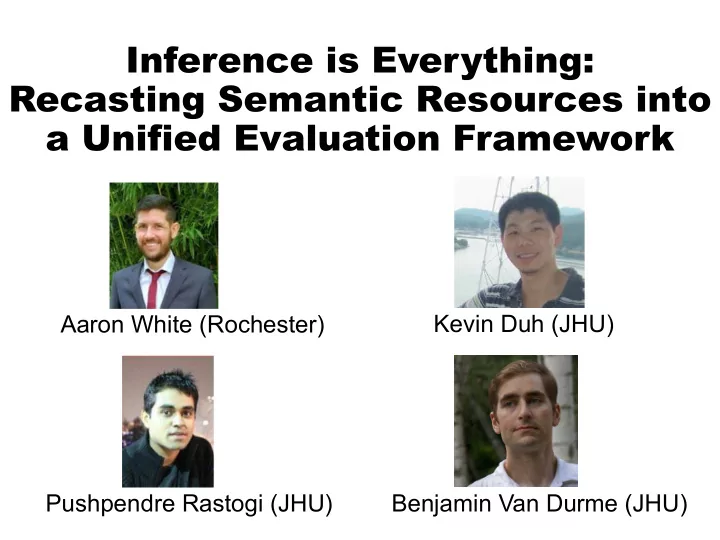

Inference is Everything: Recasting Semantic Resources into a Unified Evaluation Framework Aaron White (Rochester) Kevin Duh (JHU) Pushpendre Rastogi (JHU) Benjamin Van Durme (JHU)
Have you ever What experienced this? next? Accuracy Amazing = New Model 76% e.g. for Recognizing e.g. Stanford Natural Language Textual Entailment (RTE) Inference (SNLI) dataset
Ideally… Improve Actionable results lexical semantics! Improve Accuracy anaphora resolution! Amazing = New Model 76%
Idea (for RTE) Existing resources conversion Amazing 76% 55% 99% New Model Focused Evaluation Datasets that probe different linguistic phenomena
Previous work with similar motivations • FraCaS [Cooper et. al. 1996] • Manually constructed test suite to probe a range of semantic phenomena • bAbI [Weston et. al. 2016] • Automatically generated test suite to probe different capabilities needed in question answering • Challenge set for Machine Translation [Isabelle, 2017] • Manually constructed reference set to test subject-verb agreement, noun compounds, question syntax, etc.
Outline 1. Motivation 2. Creating focused RTE datasets 3. Case study: debugging neural models
Recognizing Textual Entailment (RTE) Dagan et al., 2006, 2013; Bar-Haim et al., 2006; Giampiccolo et al., 2007, 2009; Bentivogli et al., 2009, 2010, 2011 Text Hypothesis A couple men are playing Some men are playing a soccer sport Relation Entailed
Stanford Natural Language Inference data (SNLI) Bowman et al. 2015 570k Mechanical Turk Image hypothesis- Captions text pairs Flickr30k Large-scale data enables training Young et al. 2014 sophisticated models. But maybe not ideal for evaluation: no fine-grain relations.
Our contributions An evaluation framework based on recasting existing classification datasets to RTE, e.g.: Definite Pronoun FrameNet Semantic Proto- Resolution (DPR) Plus (FN+) Roles (SPR) Rahman and Ng 2012 Pavlick et al. 2015 Reisinger et al., 2015
Recasting Definite Pronoun Resolution (DPR) to RTE Original classification task: - Map pronoun to coreferential element. - A step towards the Winograd Challenge The bee landed on the flower because... ý þ (a) it wanted pollen. (b) it had pollen.
The bee landed on the flower because... ý þ (a) it wanted pollen. (b) it had pollen. Hypothesis: Text: (a), pronoun resolved correct sentence (a) The bee landed on the The bee landed on the flower because flower because it wanted pollen. the bee wanted pollen. Relation Entailed.
The bee landed on the flower because... ý þ (a) it wanted pollen. (b) it had pollen. Hypothesis: Text: (b), pronoun resolved correct sentence (a) The bee landed on the The bee landed on the flower because flower because it wanted pollen. the bee had pollen. Relation Not Entailed.
Recasting FrameNet Plus (FN+) to RTE Original data: - Applied paraphrase to FrameNet triggers - Turker judged on 5-point scale how much meaning was retained So our work must continue. Paraphrase rating = 4 So our labor must continue. 1-3 rating Not entailed 4-5 rating Entailed
So our work must continue. Paraphrase rating = 4 So our labor must continue. Hypothesis Text So our work So our labor must continue. must continue. Relation Entailed.
So our work must continue. Paraphrase rating = 1 So our occupation must continue. Hypothesis Text So our work So our occupation must continue. must continue. Relation Not Entailed.
Recasting Semantic Proto-Roles (SPR) to RTE EXAMPLES: • T: I heard parts of the building above my head cracking • H: I was aware of being involved in the hearing • T: UNESCO converted the founding U.N. ideals of individual rights and liberty into peoples’ rights • H: UNESCO existed after the converting stopped • T: THE IRS delays several deadlines for Hugo's victims • H: THE IRS caused the delaying to happen.
Semantic Proto-Roles • What’s the number and character of thematic roles in the syntax/semantics interface? • AGENT and PATIENT • BENEFICIARY? RECIPIENT? Fuzzy boundaries? • Dowty (1991) introduced Proto-Agent, Proto-Patient fine-grained properties • Did the argument change state? • Did the argument have volition in the change?
Example Semantic Proto-Role Properties
Focused RTE Dataset characteristics
Outline 1. Motivation 2. Creating focused RTE datasets 3. Case study: debugging neural models
2-way entailed vs. not classifier Train on SNLI Evaluated on recasted focused RTE datasets: Definite Pronoun FrameNet Semantic Proto- Resolution (DPR) Plus (FN+) Roles (SPR)
2-way entailed vs. not classifier Train on SNLI Fails in pronouns. 85% Better in paraphrase. Generally, difficult tasks Evaluated on recasted focused RTE datasets: 49% 62% 58% Definite Pronoun FrameNet Semantic Proto- Resolution (DPR) Plus (FN+) Roles (SPR)
Train on DPR Train on FN+ Train on SPR Eval on DPR Eval on FN+ Eval on SPR 50% 81% 81% Failure to Still fails at generalize from pronouns SNLI training Train on SNLI Evaluated on recasted focused RTE datasets: 49% 62% 58% Definite Pronoun FrameNet Semantic Proto- Resolution (DPR) Plus (FN+) Roles (SPR)
Summary Actionable Results? Accuracy Amazing = New Model 76% e.g. for Recognizing e.g. Stanford Natural Language Textual Entailment (RTE) Inference (SNLI) dataset
Summary Existing resources conversion Amazing 76% 55% 99% New Model Focused Evaluation Datasets that probe different semantic phenomena (Data available at http:// decomp.net ) .
Data Validation • Manual check of 100 pairs per dataset
Recommend
More recommend